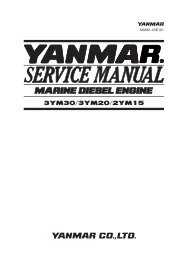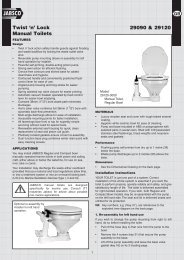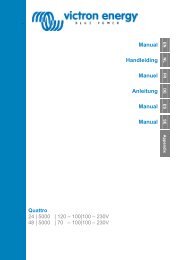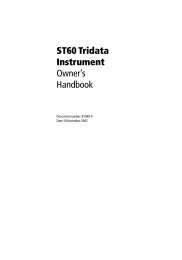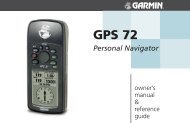AIS 650 Installation manual - Zanshin
AIS 650 Installation manual - Zanshin
AIS 650 Installation manual - Zanshin
You also want an ePaper? Increase the reach of your titles
YUMPU automatically turns print PDFs into web optimized ePapers that Google loves.
• Not all vessels are fitted with <strong>AIS</strong><br />
• Although it is mandatory for larger commercial vessels to carry<br />
<strong>AIS</strong>, it is not mandatory to use it.<br />
<strong>AIS</strong> should be used only to augment radar information, not substitute<br />
it.<br />
Warning: <strong>AIS</strong> limitation<br />
Never assume that your <strong>AIS</strong> is detecting all vessels<br />
in the area. Always exercise due prudence and do<br />
not use <strong>AIS</strong> as a substitute for sound navigational<br />
judgement.<br />
Classes of <strong>AIS</strong><br />
The <strong>AIS</strong>350 is a receiver that receives messages from vessels,<br />
land base stations, or aids to navigation (AToNs) carrying Class A<br />
or Class B transceivers.<br />
The <strong>AIS</strong><strong>650</strong> is a Class B transceiver that receives messages from<br />
and transmits messages to vessels, land base stations, or aids to<br />
navigation (AToNs) carrying Class A or Class B transceivers.<br />
Class A transceivers<br />
Class A <strong>AIS</strong> transceivers transmit and receive <strong>AIS</strong> signals. <strong>AIS</strong><br />
transceivers are currently mandatory on all commercial vessels<br />
exceeding 300 tons that travel internationally (SOLAS vessels).<br />
The following information can be transmitted by a Class A <strong>AIS</strong><br />
system:<br />
• Static data. Includes information such as vessel name, vessel<br />
type, MMSI number, call sign, IMO number, length, beam and<br />
GPS antenna location.<br />
• Voyage related data. Includes information such as draft, cargo,<br />
destination, ETA and other relevant information.<br />
• Dynamic data. Includes information such as time (UTC), ship’s<br />
position, COG, SOG, heading, rate of turn and navigational status.<br />
• Dynamic reports. Ship’s speed and status.<br />
• Messages. Alarms and safety messages.<br />
Remember that not all vessels will transmit all of the information.<br />
Class B transceivers<br />
Class B <strong>AIS</strong> transceivers transmit and receive <strong>AIS</strong> signals, but use<br />
a reduced set of data compared to Class A (see Data Summary). A<br />
Class B <strong>AIS</strong> transceiver can be fitted on any vessel not fitted with a<br />
Class A transceiver, but is not mandatory aboard any vessel.<br />
Data Summary<br />
Data<br />
Receiver<br />
(receive)<br />
Transceiver<br />
(transmit)<br />
Transceiver<br />
(receive)<br />
Ship’s name Yes Yes Yes<br />
Type Yes Yes Yes<br />
Call sign Yes Yes Yes<br />
IMO number Yes No Yes<br />
Length and beam Yes Yes Yes<br />
Antenna location Yes Yes Yes<br />
Draft Yes No Yes<br />
Cargo<br />
Information<br />
Yes Yes Yes<br />
Destination Yes No Yes<br />
ETA Yes No Yes<br />
10 <strong>AIS</strong>350 / <strong>AIS</strong><strong>650</strong> <strong>Installation</strong> instructions








